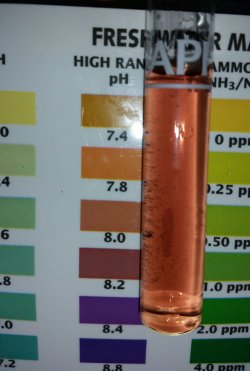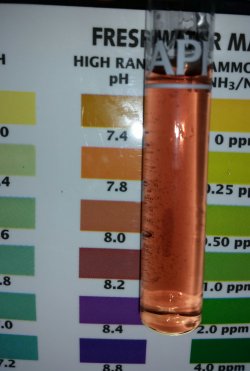Yarkii
Fish Fanatic
- Joined
- Mar 1, 2017
- Messages
- 159
- Reaction score
- 2
I'd love to hear which test kits everyone is using, and particularly if anyone knows of a test kit that isn't as subjective as the ones I've got.
I started with the API 5 in 1 Test Strips when I just had a little 2nd hand goldfish tank. It measures NO3, NO2, pH, KH & GH.
I then bought the API Freshwater Master Test Kit (pH, High Range pH, Ammonia, Nitrite & Nitrate), and the API GH & KH Test Kit.
I also bought the Seachem Alert Combo for pH & Ammonia. They sit on suction caps inside the sump.
I started cycling a new 220L tank seven days ago. I'm using aragonite & coral sand as substrate, to raise the GH & pH as I have extremely soft water but want to keep livebearers.
For the first two days I only used the Test Strip for pH, KH & GH. The pH sat at 7.0 (it was always 6-6.5 in the goldfish tank). On Day 3 I started using the API Master Test Kit, and was surprised to see the pH shoot up to between 8.0 & 8.2.
Perplexed, I tried using a Test Strip as well, and it showed the pH as 7.0. That's a big difference.
There was an anomaly with the GH readings as well: 5 drops = 89.5ppm using the Master Kit, but 180ppm or more using the Test Strip.
By Day 4 I started using a measuring syringe to fill the test tubes, and realised that I might not have had a full 5mL in the Day 3 tests. The pH using the Master Kit read as 7.8, which was better than the previous day's reading. I didn't use a test strip as I'm almost out of them, but instead read the Seachem alert, which read 7.4 for the pH. GH was 8 drops = 143.2 (I find the decimal place rather amusing, when this is all so very inaccurate.)
On Day 5 I only tested ammonia & nitrite, using the API Master Test Kit.
On Day 7 (today), according to the API Master Test Kit, the pH is 8.0, or maybe more, and the GH was 8 drops = 143.2. According to the API Test Strip, the pH is 7.5, and the GH is 120+. According to the Seachem alert, the pH is 7.4. So that's three different pH readings with three different tests, and two different GH readings with two different tests.
With Ammonia, I've only got the API Master Test Kit & the Seachem Alert. On Day 1, when I added the calculated amount of ammonia to reach 3ppm, the API test kit read between 2 & 4, so I was happy with that. By Day 3 it read as 1ppm. By Day 4 it read as between 0.5 & 1ppm. But - by Day 4 I had the Seachem Alert in there, and it measures 0.05ppm, rather than 0.5ppm. Aaargh!!!!
Today the Ammonia reads between 0.25 & 0.5ppm (closer to 0.5ppm) on the API Master Test Kit, but still shows as 0.05ppm on the Seachem Alert.
Could it be that I've got a bad batch of tests in the Master Test Kit? Or that one or both of the other test types are faulty?
Nitrite readings (now that I have them) seem more closely aligned between tests: 2.0ppm+ on the API Master Test Kit and 3.0 on the API Test Strip.
The inconsistency between tests is driving me bonkers. Is there a test that doesn't rely so heavily on getting the water measurement precise (I'll have to purchase a better water measurement device I guess), the lighting in the room & subjective interpretation of colour similarities and differences? I just want to know what the water parameters really are.
TIA

Sent from my SM-G900I using Tapatalk
I started with the API 5 in 1 Test Strips when I just had a little 2nd hand goldfish tank. It measures NO3, NO2, pH, KH & GH.
I then bought the API Freshwater Master Test Kit (pH, High Range pH, Ammonia, Nitrite & Nitrate), and the API GH & KH Test Kit.
I also bought the Seachem Alert Combo for pH & Ammonia. They sit on suction caps inside the sump.
I started cycling a new 220L tank seven days ago. I'm using aragonite & coral sand as substrate, to raise the GH & pH as I have extremely soft water but want to keep livebearers.
For the first two days I only used the Test Strip for pH, KH & GH. The pH sat at 7.0 (it was always 6-6.5 in the goldfish tank). On Day 3 I started using the API Master Test Kit, and was surprised to see the pH shoot up to between 8.0 & 8.2.
Perplexed, I tried using a Test Strip as well, and it showed the pH as 7.0. That's a big difference.
There was an anomaly with the GH readings as well: 5 drops = 89.5ppm using the Master Kit, but 180ppm or more using the Test Strip.
By Day 4 I started using a measuring syringe to fill the test tubes, and realised that I might not have had a full 5mL in the Day 3 tests. The pH using the Master Kit read as 7.8, which was better than the previous day's reading. I didn't use a test strip as I'm almost out of them, but instead read the Seachem alert, which read 7.4 for the pH. GH was 8 drops = 143.2 (I find the decimal place rather amusing, when this is all so very inaccurate.)
On Day 5 I only tested ammonia & nitrite, using the API Master Test Kit.
On Day 7 (today), according to the API Master Test Kit, the pH is 8.0, or maybe more, and the GH was 8 drops = 143.2. According to the API Test Strip, the pH is 7.5, and the GH is 120+. According to the Seachem alert, the pH is 7.4. So that's three different pH readings with three different tests, and two different GH readings with two different tests.
With Ammonia, I've only got the API Master Test Kit & the Seachem Alert. On Day 1, when I added the calculated amount of ammonia to reach 3ppm, the API test kit read between 2 & 4, so I was happy with that. By Day 3 it read as 1ppm. By Day 4 it read as between 0.5 & 1ppm. But - by Day 4 I had the Seachem Alert in there, and it measures 0.05ppm, rather than 0.5ppm. Aaargh!!!!
Today the Ammonia reads between 0.25 & 0.5ppm (closer to 0.5ppm) on the API Master Test Kit, but still shows as 0.05ppm on the Seachem Alert.
Could it be that I've got a bad batch of tests in the Master Test Kit? Or that one or both of the other test types are faulty?
Nitrite readings (now that I have them) seem more closely aligned between tests: 2.0ppm+ on the API Master Test Kit and 3.0 on the API Test Strip.
The inconsistency between tests is driving me bonkers. Is there a test that doesn't rely so heavily on getting the water measurement precise (I'll have to purchase a better water measurement device I guess), the lighting in the room & subjective interpretation of colour similarities and differences? I just want to know what the water parameters really are.
TIA
Sent from my SM-G900I using Tapatalk



 /hannainst.com/hi700-ammonia-...N1nV3EkqoxJzNrfAeZsrUFnuunaYIVg4lfhoCB6nw_wcB
/hannainst.com/hi700-ammonia-...N1nV3EkqoxJzNrfAeZsrUFnuunaYIVg4lfhoCB6nw_wcB